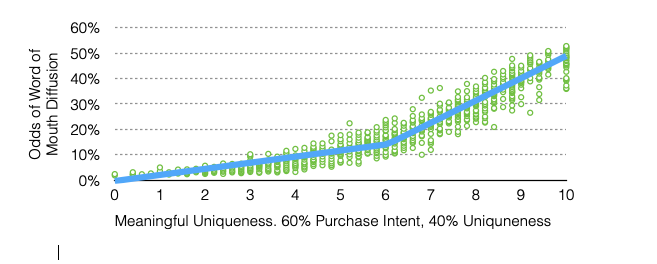The Eureka! Ranch started measuring word of mouth diffusion and running experiments in 2010. Back then companies had concerns over growing advertising costs and were looking for alternative ways to drive awareness for their new offerings. Well, today is no different. Companies are still looking to increase sales and drive down marketing costs. If leveraging word of mouth or ‘going viral’ seems like an unlikely, miracle solution, well it sort of is. While it is possible to increase the odds, we also have to be realistic about what it takes to be successful.
- A Very Meaningfully Unique Product: To be successful with word-of-mouth sales, the product has to be meaningfully unique. No surprises here, we always emphasize meaningful uniqueness for new product success. The difference is that the success stand is higher. People don’t tell others about everything they’ve ever bought, instead, they talk about the things that really stood out or were the most meaningful. So while a score above 6 for meaningful uniqueness is great for a new product, the odds of word of mouth don’t start taking off until above 7.

2. Clear Messaging: Assuming you have a meaningfully unique product that tested well, now you need to be able to communicate that in a way that others can repeat. This creates tension because new unique products can be more difficult to explain. So as teams try to simplify the messaging they can remove important claims. Often times they gloss over the uniqueness even though this is the very thing that is the most newsworthy.
3. Right-Sized Activation Events or Campaigns: You still need some awareness to kick start the word-of-mouth diffusion. But it turns out that customers who were already aware, are more likely to tell others after hearing about the product for a second time. So there is value to activation events and awareness campaigns even with a word of mouth plan. The key is to start small enough to allow word of mouth the opportunity to work, but also not so small that the product is not available by the time people learn about it. Using sales forecasting tools that include diffusion allows you to dial in the best plan for your marketing.
4. Target the Right Customers: The biggest change since the start of this research is the rise of digital marketing with digital spending passing all traditional advertising around 2019. Digital ads enable more control to target markets, but this applies to non-digital too.
To identify which customers to target:
- look at the demographics for who scored the product most meaningfully unique.
- likely going to be customers who purchase in your category already (assuming a category exists).
- people are in a position to tell other likely customers, for example targeting bartenders for alcohol products. This may require different messaging that is meaningfully unique to them.
5. Data Tracking or Experiment to Improve Your Systems: Honestly most of these strategies require work that you should already be doing for any new product regardless of intentions to spark word-of-mouth sales. However, if you are not intentional about tracking data, you won’t have the information you need to learn and improve your system for the next product. Depending on your industry you may be able to track how someone learned about the product or track enabling metrics that predict word of mouth. Our research and models are based on a broad range of products, so we can apply our learning to a variety of categories. While some things are the same across categories, there are likely some nuances that you can take advantage of in your industry or category. We recently published a white paper summarizing our experiment and results which would be a good place to start for designing your own research or experiment.


Excellent summary, Greg – we will repost this in our channels. Thank you for all your help in 2021!
Clear and easy to understand. If you can’t get some good word of mouth-you may not have a Meaningfully Unique offering..